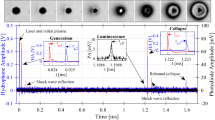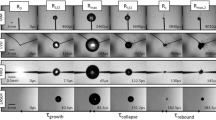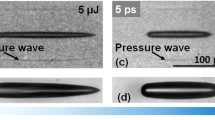Abstract
A novel experimental method for the measurement of cavitation bubble dynamics is presented. The method makes use of a collimated cw HeNe laser beam that is focused onto a photodiode. A cavitation bubble centered in the laser beam leads to refraction and thus changes the diode signal. With sufficient temporal resolution of the measurement, the evolution of the bubble dynamics, and in particular, the collapse, could be well resolved (limitation is only due to diode response and oscilloscope bandwidth). In the present work this is demonstrated with cavitation bubbles generated with high-power nanosecond and femtosecond laser pulses, respectively. Bubble evolution is studied in two different liquids (water and glycerine) and at different temperatures and pressures.








Similar content being viewed by others
References
A. de Bosset, D. Obreschkow, P. Kobel, N. Dorsaz, M. Farhat, in 58th International Astronautical Congress (2007). IAC-07-A2.4.04
O. Lindau, W. Lauterborn, AIP Conf. Proc. 524, 385 (2000)
A. Vogel, S. Bush, U. Parlitz, J. Acoust. Soc. Am. 100, 148 (1996)
P. Gregorcic, R. Petkovsek, J. Mozina, G. Mocnik, Appl. Phys. A 93, 901 (2008)
C.S. Peel, X. Fang, S.R. Ahmad, Appl. Phys. A 103, 1131 (2011)
B.P. Barber, R.A. Hiller, R.A.R. Löfstedt, S.J. Putterman, Phys. Rep. 281, 65 (1997)
E.M. Englert, A. McCarn, G.A. Williams, Phys. Rev. E 83, 046306 (2011)
L. Rayleigh, Philos. Mag. 34, 94 (1917)
F. Hegedüs, S. Koch, W. Garen, Z. Pandula, G. Paál, U. Teubner, L. Kullmann, The effect of high viscosity on compressible and incompressible Rayleigh–Plesset-type bubble models. Int. J. Heat Fluid Flow (2012, submitted)
Acknowledgement
This work has been supported by the Research Committee of the University of Applied Sciences Emden/Leer.
Author information
Authors and Affiliations
Corresponding author
Appendix A: Ray optics of beam deflection and estimate of diode signal
Appendix A: Ray optics of beam deflection and estimate of diode signal
1.1 A.1 Refraction geometry
Figure 9 shows the geometry of rays of the diagnostic beam when a bubble is present. If y is not too large, e.g., y=y 1, the ray is refracted at both interfaces between liquid and bubble as shown in Fig. 9. The total angular change could be calculated from the following geometrical relations and from Snell’s law, respectively:

As long as
refraction occurs. By means of the above six equations the angle of deflection ϵ can be calculated as
In the opposite case (ray at y=y 2 or at y=y 3), the ray is totally reflected or unaffected (see Sect. 2).
1.2 A.2 Diode signal without bubble
For an intensity profile of the diagnostic beam with a Gaussian intensity profile (see Sect. 2),
the power measured behind an aperture of diameter 2R is obtained by integrating over the aperture area, i.e.
For an aperture like that in the setup shown in Fig. 1, R=r a has to be inserted. This yields P(R=r a )=J 0 and thus leads to Eq. (1) in Sect. 2.
1.3 A.3 Diode signal with a bubble present and the aperture positioned in infinity (i.e. L → ∞)
In this case, the bubble acts like a disk. Due to deflection it blocks part of the diagnostic beam. This part could be calculated with Eq. (7) by setting R=r b . In the present setup (see Fig. 1), behind the aperture, J 0, is thus reduced to J(ζ)=J 0−P(R=r b ) which yields Eq. (2) in Sect. 2 (with q ≡ 1). Now, it is assumed that the diode signal, i.e. the voltage U(ζ), is proportional to J(ζ) and U 0 is the signal obtained for J 0. Defining u(ζ)=U(ζ)/U 0, this is equal to J(ζ)/J 0 and can thus be solved for r b with Eq. (2). The result is Eq. (3) (with q ≡ 1).
1.4 A.4 Diode signal with a bubble present and the aperture positioned at finite distance
If L is finite, rays that are only very slightly deflected may pass the aperture and thus lead to a “leakage signal” on the photodiode (see Fig. 10). As may be seen from the image observed behind the aperture (Fig. 3), in particular, this is the case for the ray on the axis and for those rays that are very close to the optical axis: The maximum value of ϵ that leaks through the aperture is obtained from ϵ max≈(r a −y max)/L which usually is very small (because r a ≪L). By inserting ϵ max into Eq. (6) (with small angle approximation of the argument) Eq. (6) may be solved for y max.
Although the bubble still blocks part of the diagnostic beam, the blocked signal consequently has to be calculated again by an integration similar to Eq. (7), but now with integration from y max to r b (instead of integration from zero to r b ). This leads to modifications of Eqs. (2) and Eq. (3) with a correction q that depends on ζ or r b , respectively. The resulting q is given by Eq. (4) (one may note that q=1 for L as expected for the case that the aperture is very far away).
Finally, it should be mentioned that rays at large values of y (y close to r b ) get totally reflected also at small angles ϵ and thus may leak through the aperture, too. However, as in the case above, it was verified that again, this leakage is neglible.
Rights and permissions
About this article
Cite this article
Koch, S., Garen, W., Hegedüs, F. et al. Time-resolved measurements of shock-induced cavitation bubbles in liquids. Appl. Phys. B 108, 345–351 (2012). https://doi.org/10.1007/s00340-012-5070-1
Received:
Published:
Issue Date:
DOI: https://doi.org/10.1007/s00340-012-5070-1






